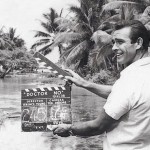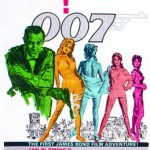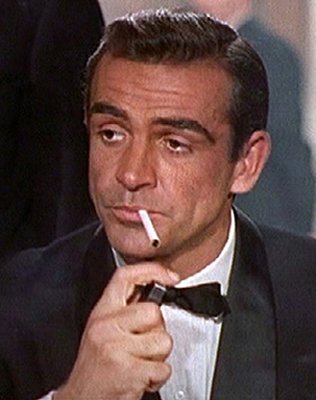
Sixty years ago this month, in October, 1962, a new kind of action movie, and a new kind of hero, took cinema box offices by storm, to the evident relief and delight of Bond producers Albert R. Broccoli and Harry Saltzman.
The two men had formed a partnership and taken a huge gamble on bringing James Bond to the Big Screen, and Dr. No, with Sean Connery as Ian Fleming’s creation, became a smash-hit. The first 007 movie, of course, started something of a cinema revolution and arguably led to the creation of the most successful long-term franchise in modern film history.
As part of the 60th Anniversary celebrations, the JBIFC takes the opportunity to offer (00)7 pieces of info about the first Bond movie, some familiar, others less so. Let’s face it: as the nights begin to draw in across Britain and the evenings get longer, what better way to face this daunting prospect than to settle down and re-watch our favourite spy, and also recall where it all began?
For some Bond aficionados, especially those who missed out on the opportunity to see Sean Connery’s Bond in action on the big screen, either as a stand-alone movie or in the famous double bills of the 1960s and 1970s, the chance to catch James Bond on the big screen during the summer of 2022 has helped reinforce their appreciation of the evolution of the series, and how there was both continuity and change over the twenty-five smash-hit EON 007 adventures.
Lets take a look back briefly on Dr. No, where it all began, and the main villain who gave the film its punchy title.
007 and Counting…
001: A core part of any James Bond movie is the villain. Although the actor who played Julius No, stage and screen star Joseph Wiseman, passed away in 2009, there is general agreement that the multi-talented Canadian actor set the precedent for future EON Bond villains. His interpretation of Ian Fleming’s ‘No’ for the big screen gave the character a highly memorable machine-like quality, combining both menace and ego with a brief ironic nod towards culture and civilization. Back in 1958, with the creation of ‘Dr. No’ for his sixth novel, Bond author Ian Fleming had embodied his villain with all the cruelty of a psychotic torturer, but also with the trappings of a very modern villain, who had a particular fascination with science and technology. Joseph Wiseman, encouraged by director Terence Young, arguably captured the essence of this very well.
002: The film-makers also came up with some inspired touches during filming. After agent 007 (played by Sean Connery in his debut Bond film) – having been ‘decontaminated’ and temporarily drugged – finds himself now trapped in Dr. No’s multi-million dollar lair deep underground, at one point he spots Goya’s famous oil painting of the Duke of Wellington, and realises his dangerous host still has a taste for culture (of a kind). This was also a great in-joke for early 1960s UK audiences, as the highly-valuable painting had recently been stolen in real life from the National Gallery in London’s Trafalgar Square!

003: The movie (released on October 5, 1962, at the Pavilion cinema in London) also had tremendous visual impact, undoubtedly aided by the hugely creative talents and eye for detail of the late set designer Ken Adam (1921-2016). Sir Ken revealed in various interviews that he took inspiration for Dr. No’s HQ from some of the photographs of real-life German Nazi lairs published in the fashion and ‘style’ magazines of the 1930s, luxury lairs which combined a sense of evil menace and villainy with a backdrop of Germanic ‘culture’ (warm fireplaces, rugs on floors, classical oil paintings, expensive silver cutlery, and so on).
004: Even more successfully, the script for Dr. No was notably contemporary, and explored the villain’s plans to disrupt the American Project Mercury Space launch through ‘rocket toppling’, playing skilfully upon early 1960s ambivalence about science, atomic power and super hi-technology. What might now seem to a modern audience to be quaint and rather strange, with odd ideas about ‘atomic’ energy and satellite disruption, was – to a 1962 cinema-going audience – both exciting and also a little frightening, given the international Cold War tensions of the time. And experiments with ‘atomic power’ and radiation was used to explain the Doctor’s lack of hands.

005: Compared to the usual ‘kitchen sink’ dramas that were tending to come out of UK studios in the late 1950s, Cubby Broccoli and Harry Saltzman’s big screen version of Dr. No gave cinema audiences exotic adventure, colourful and sunny locations, and what seemed like (at the time) lashings of permissive sex. As with the Ian Fleming novels, the first big-screen version of Bond also appeared to herald the beginnings of a new decade of optimism and consumer materialism, especially for British viewers after the rather drab years of the rationing of the 1950s.
006: Although he was ambivalent about the role in later years, there is no doubt Wiseman’s interpretation contributed to what became the standard template for the strange and menacing Bond villains who appeared subsequently on screen. As John Brosnan noted in his early and affectionate study of the James Bond films, James Bond in the Cinema (1972), although Wiseman did not have much physical resemblance to the novel’s version of Julius No, on an emotional level Wiseman’s performance ‘was flawless’. Reflecting on Wiseman’s portrayal, John Brosnan observed: ‘He captures perfectly the inhuman, machine-like quality of Dr. No. Every movement is careful and precise, the face remains blank and the voice as bland as a computer. The overall effect is one of supreme confidence mingled with total ruthlessness – the “Grand Inquisitor” of the novel’.
007: In hindsight, Joseph Wiseman’s performance, Sean Connery’s sheer physical energy and visual impact as suave agent 007, Ursula Andress’s astonishing beauty, Ken Adam’s iconic sets, and Monty Norman’s immortal James Bond theme (arranged by John Barry), all combined to make Dr. No one of the truly ground-breaking films of the early 1960s, and certainly helped give birth to one of the most successful film franchises in the cinema. Often difficult to please, some of the early film critics in Britain were quite divided about the new movie. However, one of the film’s most enthusiastic UK supporters was the film critic of the Sunday Times, Dylis Powell, who praised the combination of humour and tension, and added ‘now for the next, please’.
Did You Know?
A number of scenes in Dr. No caused unease with both the censors and also with studio executives. One of these scenes was where Sean Connery’s 007 waited quietly for Professor Dent (played by Anthony Dawson) at Miss Taro’s apartment. Dent fires six shots at what he thinks is James Bond and Miss Taro sleeping in her bed in the darkness, but a seated Bond switches on the light and orders Dent to drop his gun. The scene culminates in Bond shooting Dent in the chest with his silencer, and then once again in the Professor’s back.
Director Terence Young recalled that this ’caused a lot of heartache’ across the Atlantic with United Artists studio executives, who were not happy about it in previews. But Young carefully explained the reasons why, and managed to talk them round. Bond, according to Young, was not just an old style ‘traditional’ Hollywood hero – he was a new kind of modern spy issued with a licence to kill, who could be ruthless and hard-headed where necessary.

The world’s first view of Sean Connery as 007
